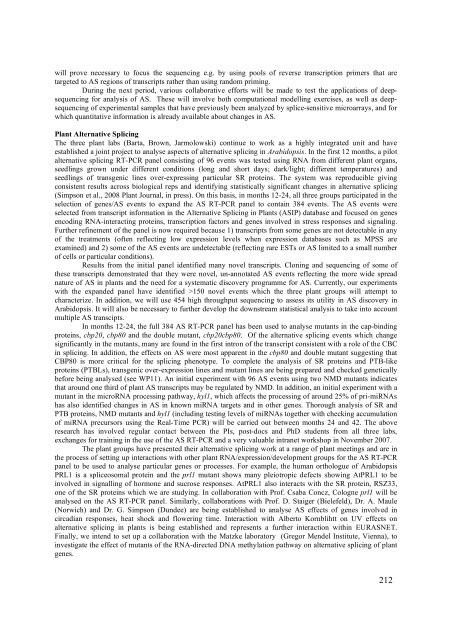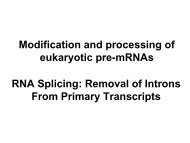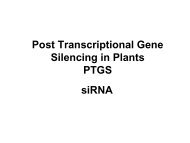You also want an ePaper? Increase the reach of your titles
YUMPU automatically turns print PDFs into web optimized ePapers that Google loves.
will prove necessary to focus the sequencing e.g. by using pools of reverse transcription primers that aretargeted to AS regions of transcripts rather than using random priming.During the next period, various collaborative efforts will be made to test the applications of deepsequencingfor analysis of AS. These will involve both computational modelling exercises, as well as deepsequencingof experimental samples that have previously been analyzed by splice-sensitive microarrays, and forwhich quantitative information is already available about changes in AS.Plant Alternative SplicingThe three plant labs (Barta, Brown, Jarmolowski) continue to work as a highly integrated unit and haveestablished a joint project to analyse aspects of alternative splicing in Arabidopsis. In the first 12 months, a pilotalternative splicing RT-PCR panel consisting of 96 events was tested using RNA from different plant organs,seedlings grown under different conditions (long and short days; dark/light; different temperatures) andseedlings of transgenic lines over-expressing particular SR proteins. The system was reproducible givingconsistent results across biological reps and identifying statistically significant changes in alternative splicing(Simpson et al., <strong>2008</strong> Plant Journal, in press). On this basis, in months 12-24, all three groups participated in theselection of genes/AS events to expand the AS RT-PCR panel to contain 384 events. The AS events wereselected from transcript information in the Alternative Splicing in Plants (ASIP) database and focused on genesencoding RNA-interacting proteins, transcription factors and genes involved in stress responses and signaling.Further refinement of the panel is now required because 1) transcripts from some genes are not detectable in anyof the treatments (often reflecting low expression levels when expression databases such as MPSS areexamined) and 2) some of the AS events are undetectable (reflecting rare ESTs or AS limited to a small numberof cells or particular conditions).Results from the initial panel identified many novel transcripts. Cloning and sequencing of some ofthese transcripts demonstrated that they were novel, un-annotated AS events reflecting the more wide spreadnature of AS in plants and the need for a systematic discovery programme for AS. Currently, our experimentswith the expanded panel have identified >150 novel events which the three plant groups will attempt tocharacterize. In addition, we will use 454 high throughput sequencing to assess its utility in AS discovery inArabidopsis. It will also be necessary to further develop the downstream statistical analysis to take into accountmultiple AS transcipts.In months 12-24, the full 384 AS RT-PCR panel has been used to analyse mutants in the cap-bindingproteins, cbp20, cbp80 and the double mutant, cbp20cbp80. Of the alternative splicing events which changesignificantly in the mutants, many are found in the first intron of the transcript consistent with a role of the CBCin splicing. In addition, the effects on AS were most apparent in the cbp80 and double mutant suggesting thatCBP80 is more critical for the splicing phenotype. To complete the analysis of SR proteins and PTB-likeproteins (PTBLs), transgenic over-expression lines and mutant lines are being prepared and checked geneticallybefore being analysed (see WP11). An initial experiment with 96 AS events using two NMD mutants indicatesthat around one third of plant AS transcripts may be regulated by NMD. In addition, an initial experiment with amutant in the microRNA processing pathway, hyl1, which affects the processing of around 25% of pri-miRNAshas also identified changes in AS in known miRNA targets and in other genes. Thorough analysis of SR andPTB proteins, NMD mutants and hyl1 (including testing levels of miRNAs together with checking accumulationof miRNA precursors using the Real-Time PCR) will be carried out between months 24 and 42. The aboveresearch has involved regular contact between the PIs, post-docs and PhD students from all three labs,exchanges for training in the use of the AS RT-PCR and a very valuable intranet workshop in November 2007.The plant groups have presented their alternative splicing work at a range of plant meetings and are inthe process of setting up interactions with other plant RNA/expression/development groups for the AS RT-PCRpanel to be used to analyse particular genes or processes. For example, the human orthologue of ArabidopsisPRL1 is a spliceosomal protein and the prl1 mutant shows many pleiotropic defects showing AtPRL1 to beinvolved in signalling of hormone and sucrose responses. AtPRL1 also interacts with the SR protein, RSZ33,one of the SR proteins which we are studying. In collaboration with Prof. Csaba Concz, Cologne prl1 will beanalysed on the AS RT-PCR panel. Similarly, collaborations with Prof. D. Staiger (Bielefeld), Dr. A. Maule(Norwich) and Dr. G. Simpson (Dundee) are being established to analyse AS effects of genes involved incircadian responses, heat shock and flowering time. Interaction with Alberto Kornblihtt on UV effects onalternative splicing in plants is being established and represents a further interaction within <strong>EURASNET</strong>.Finally, we intend to set up a collaboration with the Matzke laboratory (Gregor Mendel Institute, Vienna), toinvestigate the effect of mutants of the RNA-directed DNA methylation pathway on alternative splicing of plantgenes.212







